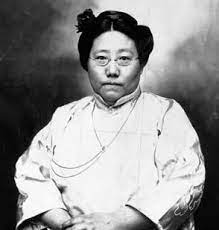K'ang Ch'eng (1873-1930), known as Ida Kahn, was a prominent physician who introduced modern medical practices and facilities to Xanchang, where she worked from 1903 until her death in 1930. A devout Methodist, she was a strong advocate of religious education and social welfare programs.
The birth of Ida Kahn, the sixth girl in a Kiukiang, Kiangsi, family of very limited means, was a disappointment to her parents, for they had hoped for a son. Accordingly, when Gertrude Howe of the Methodist Mission at Kiukiang offered to relieve the K'ang family of some financial burdens by adopting the infant, they accepted her offer.
A few years later, Ida Kahn began her education at the Rulison-Fish Memorial School at Kiukiang, which had been founded by Miss Howe. Mary Stone Shih Mei-yü, q.v.), who became her close friend and associate, also attended this school. At the age of 9, Ida Kahn accompanied Miss Howe on a trip to the United States, where she attended a home-mission school for Chinese children in San Francisco. After a brief stay in Japan and another change of school, they returned to China in 1 884 and spent two years in Chungking, where Miss Howe worked to develop a new Methodist mission center. ^Vhen they returned to Kiukiang in 1886, Ida Kahn resumed her formal education.
In 1892 Miss Howe took Ida Kahn and Mary Stone to the United States. Both girls had decided to study medicine, and they had been accepted as students by the University of Michigan Medical School. After graduation in the spring of 1896, they spent two months observing medical techniques and hospital procedures in Chicago; they returned to China in the autumn to serve as medical missionaries under the sponsorship of the Women's Foreign Missionary Society of the Methodist Episcopal Church.
Soon after their arrival in Kiukiang, Dr. Kahn and Dr. Stone won the confidence of the local residents and persuaded them to accept modern medical treatment. In their first ten months of practice, they treated more than two thousand patients at their one-room dispensary. In 1898 Dr. Isaac Newton Danforth, a Chicago physician who had befriended Dr. Stone, provided funds for the construction of a hospital. At the time of the Boxer Uprising of 1900, the two doctors were forced to abandon the newly completed building and seek refuge in Japan. They returned to Kiukiang in 1901 and formally opened the Elizabeth Skelton Danforth Hospital on 7 December.
In 1903 Ida Kahn left Kiukiang and went to Nanchang to establish a modern medical program. By the end of 1905, a new dispensary building had been completed and a site for a new hospital had been acquired Medical facilities and services increased ste^fcly. More than 8,000 patients had received treatment by the end of 1907. Despite these claims on her attention and energies, Dr. Kahn found time to develop evangelical and social reform programs and to plead for improved education in China; in 1905 she addressed the fifth triennial meeting of the Educational Association of China in Shanghai on the subject of medical education. In 1908 Ida Kahn went to the United States on leave and enrolled at Northwestern University to study literature. She completed three years of work in two years. In the spring of 1910, she went to Berlin as a delegate to a world conference of the Young Women's Christian Association. After the conference, she went to London for six months to study tropical diseases. While in London, she completed her coursework at Northwestern by correspondence and received a B.A. degree in January 1911. The following month, she returned to Nanchang. By the time of the Wuchang revolt in October 1911, a new 40-bed hospital had been completed and put into service at Nanchang. The hospital remained open throughout the revolution and gave treatment to all who required it. The hospital was constantly -in debt because many patients were treated free of charge. Dr. Kahn accepted a lucrative position in Tientsin so that she could pay the hospital's creditors. Within three years, she had discharged the debt and returned to Nanchang. When she resumed work, the Kiangsi provincial government made two financial grants to the hospital as an indication of its esteem for her and its appreciation of her contributions to the life of the province. Later, it gave periodic subsidies to ensure the hospital's continuing operation.
In 1926 the Nanchang hospital gave extensive aid to casualties of the Northern Expedition only to be repaid with valueless notes. Dr. Kahn, who was in poor health, sold her personal belongings to help the hospital meet its financial obligations. She then went to Shanghai, where she died a short time later. Throughout her career, Ida Kahn was a strong advocate of religious education, social welfare programs, and modern medical training in China. In pursuit of these ends, she wrote articles for such publications as the Atlantic Monthly, Asia, and the China Press. All of her activities reflected her deep personal concern for the physical, social, and spiritual well-being of all Chinese people.

康成
西名:艾达
康成(1873—1930年),西名爱达,将现代医术及设备传到南昌的卓越医师,她自1903年在南昌工作直到1930年去世。她是—名虔诚的卫理会教徒,坚定的宗教教育和社会着利事业倡导者。
康成出生在江齿九江一个经济拮据的家庭,她是第六个女儿,出生时父母很失望,因为他们希望有一个儿子。九江卫理会教士格待鲁德豪为了减轻她家的负担,收养这名女孩,她家中同意了。
几年后,康成在豪女士创办的九江菲什学校读书,石美瑜也进了这个学校,成了她的知已。康成九岁时随豪女士去美国,进旧金山为中国儿童设立的国内布道学校。她们在日本居住了一些时候,又转了个学校,1884年回中国,在
重庆住了两年。豪女士在那里成立了一个卫理会传教的中心。1886年,她和回到九江,康成才恢复她的正规教育。
1892年,豪女士带康成和石美瑜到美国,两人都决定学医,进了密执安大学医学院。1896年春毕业后,她们在芝加哥实习医疗技术与医院管理,是年秋天回国,在卫理圣公会国外布道会主持下行医传教。
不久,她们又到了九江。康成和石美瑜这两名医生获得了当地居民的信任,并劝说居民接受西医治疗。开始十个月间,她们在一间房的诊室里给两千多名病人治过病。1898年,一名和石美瑜友好的芝加哥医生丹福思提供经费建造了一所医院。但是1900年义和团运动时,这两名医生不得不放弃这所新建的医院到日本避难。1901年重回九江,这所以丹福思为名的医院才于12月9日正式开放。
1903年康成离九江去南昌筹建现代化的医院。1905年底,新诊疗所的建筑已完成,医院的地址也以觅定。医疗设备和服务逐淅增加。到1907年底,有八千多名病人接受了治疗,尽管这些工作占去了康成的精力,但她仍兼顾传教和社会改良事业,呼吁提髙中国的教育,1905年,她在三年召开一次的第五届中华教育会大会上作了有关医学教育的讲演。
1908年,康成休假去美国,进了西北大学研究文学,她在两年内完成了三年的课程。1910年春,去柏林出席女青年会世界大会。会后,她去伦敦学习热带疾病六个月。她在伦敦用函授法完成了她在西北大学的课程,1911年1月,取年得文学士学位。2月,她回到九江。
1911年10月武昌起义时,南昌已经有了一所四十张病床的新医院。在革命期间,该院一直收治一切需要治疗的病人。因为不少病人免费治疗,所以这所医院常常负债,康成接受了一个天津收入甚高的职位,以嚴来偿付债务。她在
三年内还清了债,又回到南昌。她重回南昌工作时,江西省当局给该医院两笔赠款,表示对她的尊敬和对她给江西省所作的贡献的感谢。以后又定期给以补助,维持了医院的工作。
1926年,南昌医院给北伐战争的伤员很大那助,但收进的却是不值一文的纸币。康成健康情况很坏,她出卖财物补助医院的开支。后来她去上海,不久死在上海。
在她的一生事业中,康成在中国大力提倡宗教教育,社会福利规划和现代医学训练。为此目的,她经常在《大西洋月刊》、《亚洲》、《大陆报》上写文章。所有这些活动,都说明她对中国群众的体质、社会和精神方面的幸福的
关怀.